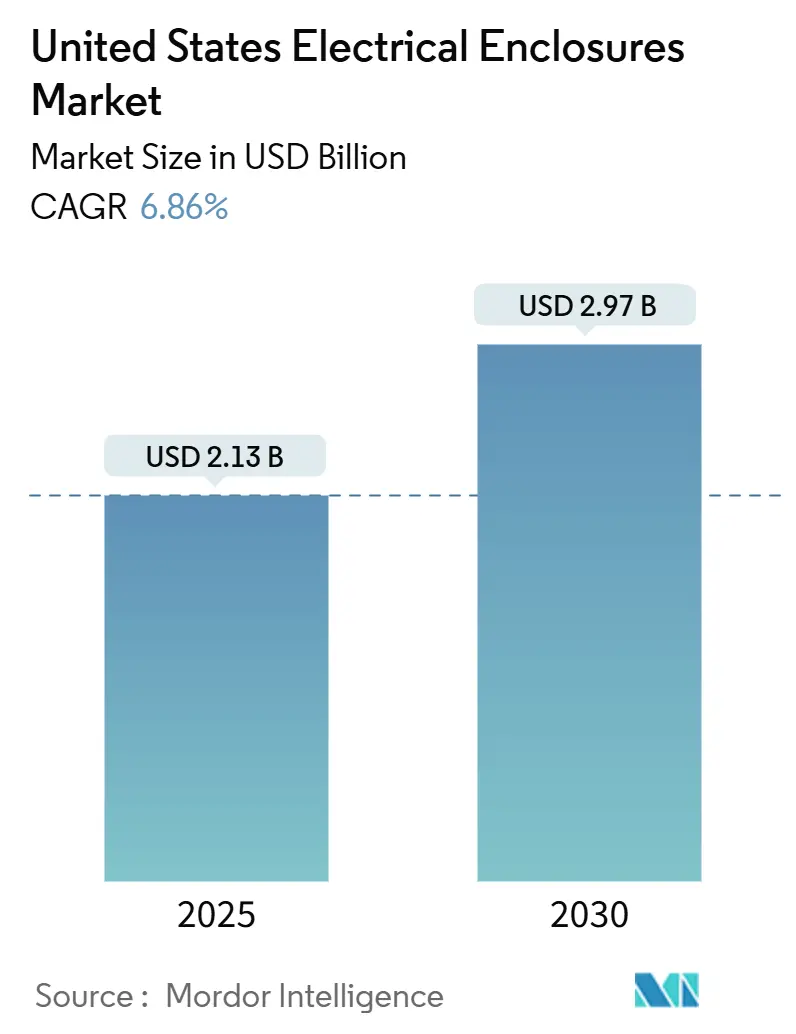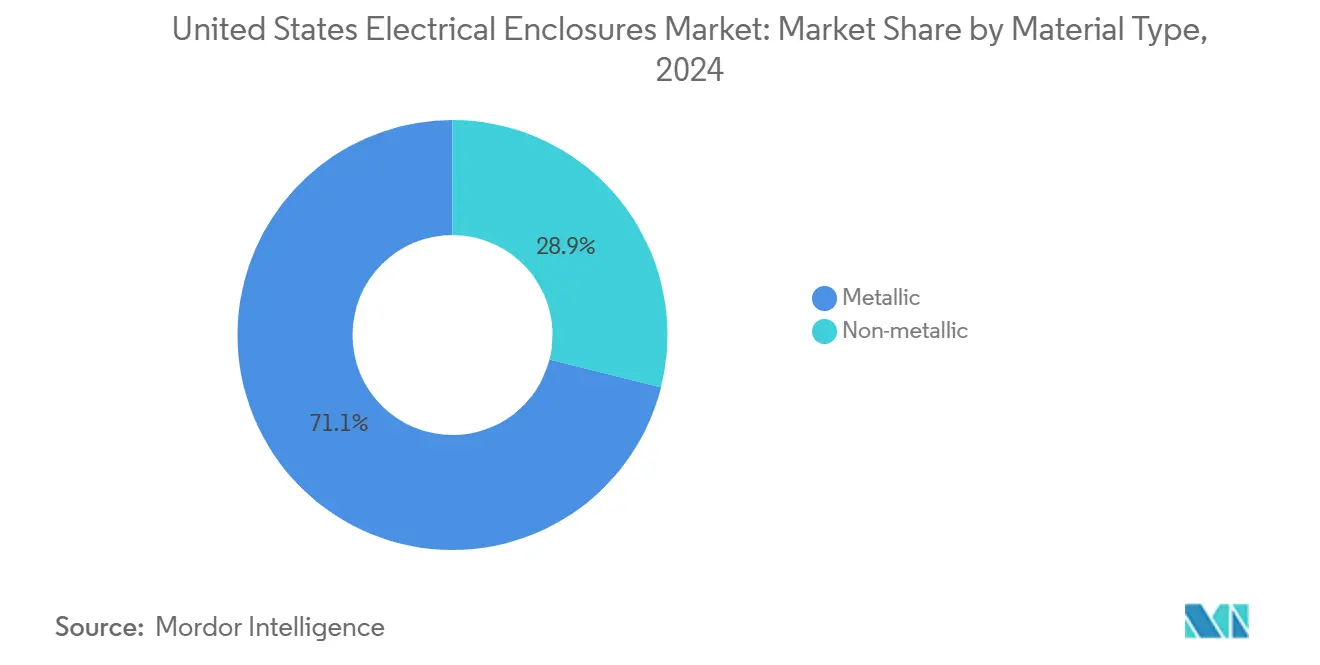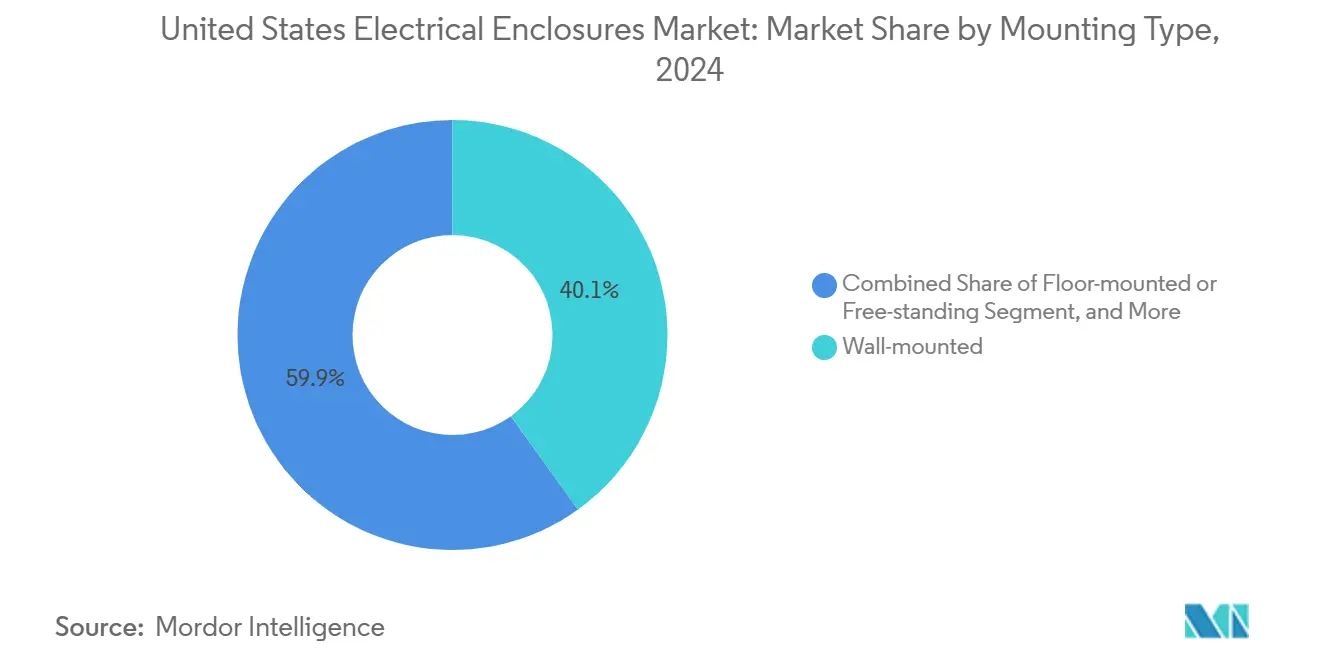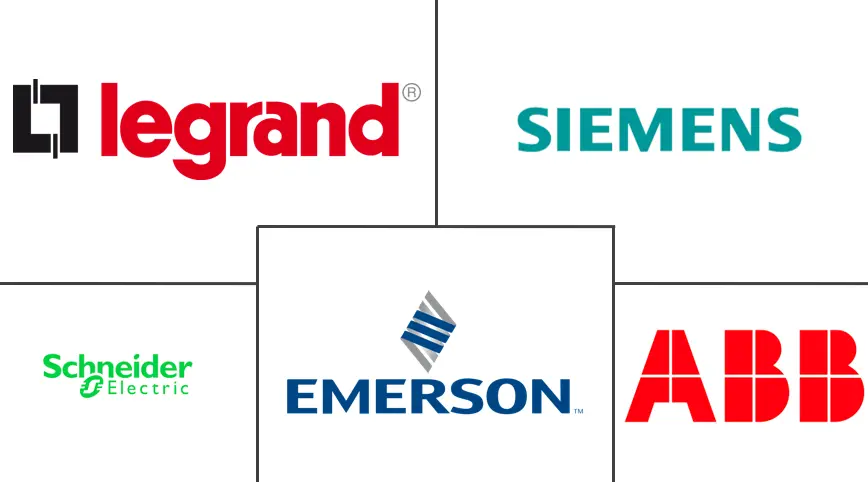
United States Electrical Enclosures Market Analysis by Mordor Intelligence
The United States Electrical Enclosures Market size is estimated at USD 2.13 billion in 2025, and is expected to reach USD 2.97 billion by 2030, at a CAGR of 6.86% during the forecast period (2025-2030).
Robust capital outlays for grid resilience, utility-scale solar projects, and electric truck charging depots are converging to sustain double-digit unit demand. Utilities alone budgeted USD 179 billion in 2024 for transmission and distribution hardware, a spending pool that directly specifies weather-sealed, cyber-secure cabinets. Data center construction running at a USD 29.99 billion annual rate is shifting the mix toward free-standing, large-volume housings suited for high-density power distribution. California’s mandate for 157,000 medium- and heavy-duty chargers by 2030 underpins a new class of megawatt-rated enclosures. These infrastructure themes collectively expand the addressable market for US electrical enclosures across utilities, renewables, transportation, and digital infrastructure.
Key Report Takeaways
- By material, metallic enclosures led with 71.07% of the US electrical enclosures market share in 2024, while non-metallic variants are expanding at a 7.42% CAGR through 2030.
- By form factor, free-size / full-size (above 50 L) accounted for 33.29% of the US electrical enclosures market size in 2024, and modular or configurable systems are projected to grow at a 7.68% CAGR through 2030.
- By mounting type, wall-mounted configurations held 40.06% share of the US electrical enclosures market size in 2024, whereas underground or pad-mounted systems are advancing at a 7.39% CAGR through 2030.
- By end-user industry, energy and power accounted for 28.18% of the US electrical enclosures market share in 2024, while data centers and telecom installations are expected to grow at the fastest rate, with a 9.39% CAGR, from 2024 to 2030.
United States Electrical Enclosures Market Trends and Insights
Drivers Impact Analysis
| Driver | (~) % Impact on CAGR Forecast | Geographic Relevance | Impact Timeline |
|---|---|---|---|
| Surging CAPEX in U.S. grid-hardening programs | +2.1% | National, with concentration in storm-prone regions | Medium term (2-4 years) |
| Rapid build-out of utility-scale solar and storage farms | +1.8% | National, with emphasis on Texas, California, Florida | Long term (≥ 4 years) |
| Electrification of commercial vehicle depots | +1.4% | National, with early adoption in California, Northeast corridor | Medium term (2-4 years) |
| Federal tax incentives for domestic panel manufacturing | +0.9% | National, with manufacturing concentration in Southeast | Long term (≥ 4 years) |
| AI-enabled predictive maintenance enclosures | +0.7% | National, with industrial clusters in Midwest, Southeast | Medium term (2-4 years) |
| Growing demand for cyber-secure IIoT ready enclosures | +0.6% | National, with critical infrastructure focus | Long term (≥ 4 years) |
| Source: Mordor Intelligence | |||
Surging CAPEX in U.S. Grid-Hardening Programs
Utility owners are boosting five-year capital plans by USD 23.5 billion, with PPL alone lifting its budget 40% to USD 20 billion. Distribution substation spend hit USD 6.1 billion in 2023, more than tripling 2003 levels.[1]U.S. Energy Information Administration, “Grid Infrastructure Investments Drive Increase in Utility Spending,” eia.gov Each retrofit specifies NEMA 4X or IP66 cabinets able to endure wind-borne debris and flood exposure while sheltering smart relays. Enhanced thermal management and EMI shielding now form baseline requirements, pushing average selling prices higher. As extreme-weather events intensify, utilities are locking in multi-year enclosure contracts, giving the US electrical enclosures market durable order visibility.
Rapid Build-Out of Utility-Scale Solar and Storage Farms
Department of Defense guide specs obligate NEMA 3R combiner boxes and NEMA 4X control cabinets that tolerate –25 °C to +57 °C ranges. Storage arrays impose stricter demands, including vented gas management sections and sealed electronics bays, as illustrated by Class I Div 2 systems from Solar Electric Supply. The boom in projects above 1 MW is enlarging physical footprints, spurring uptake of modular, stackable enclosures. Texas and Florida are setting procurement pace, and each gigawatt of solar capacity typically translates to 15,000–20,000 new cabinets. Consequently, the US electrical enclosures market is pivoting toward larger, pre-engineered assemblies with higher ingress-protection ratings.
Electrification of Commercial Vehicle Depots
Voltera’s Lynwood site operates 7.7 MW, scalable to 11 MW, serving 200 trucks daily and relying on ABB HVC360 cabinets positioned up to 328 ft from dispensers. Megawatt charging necessitates shielded housings rated to handle 1,200 kW loads and continuous thermal cycling. California’s Advanced Clean Fleets rule sets the template for nationwide NEMA 4X outdoor compliance. Integrators now favor composite walls with forced-air cooling and embedded diagnostics, elevating bill-of-materials value. Freight operators in the Northeast corridor are beginning to replicate these large-format layouts, widening regional demand for the US electrical enclosures market.
Federal Tax Incentives for Domestic Panel Manufacturing
The Inflation Reduction Act’s Advanced Manufacturing Production Credit maintains 100% payout through 2029, covering inverters, battery packs, and associated cabinets.[2]U.S. Department of Energy, “Grid Hardening Grants,” energy.gov Projects meeting 40% domestic-content thresholds can claim a 40% Investment Tax Credit. Southeast states are attracting new sheet-metal and molding lines as OEMs localize supply to verify origin. Enclosure vendors that validate U.S. steel or GRP inputs now enjoy preferential procurement status. These tax levers shorten payback periods on new tooling, encouraging capacity expansions that enlarge the US electrical enclosures market footprint over the long term.
Restraints Impact Analysis
| Restraint | (~) % Impact on CAGR Forecast | Geographic Relevance | Impact Timeline |
|---|---|---|---|
| Commodity price volatility for steel and aluminum | -1.3% | National, with manufacturing concentration impact | Short term (≤ 2 years) |
| Sluggish non-residential construction in 2024-2025 | -0.8% | National, with regional variations | Short term (≤ 2 years) |
| High certification costs for UL 508A/NEMA 4X smart enclosures | -0.5% | National, affecting smaller manufacturers | Medium term (2-4 years) |
| Limited interoperability standards for wireless sensors inside metal cabinets | -0.3% | National, industrial automation focus | Long term (≥ 4 years) |
| Source: Mordor Intelligence | |||
Commodity Price Volatility for Steel and Aluminum
New 25% tariffs on Canadian and Mexican inputs drove average steel conduit costs up 14% by March 2025, while aluminum shortages pushed panel prices 22% higher. China’s output cap at 45 million tonnes and drought-hit smelters lift global premiums, and the World Bank expects tightness to persist through 2025.[3]World Bank, “Metal Prices Set to Remain High in 2024-25,” worldbank.org U.S. producers face power rates almost double those in Canada, inflating conversion costs. Manufacturers are inserting escalation clauses and carrying larger raw-material inventories, which strains working capital and tempers the US electrical enclosures market expansion over the near term.
Sluggish Non-Residential Construction in 2024-2025
The American Institute of Architects sees non-res building growth sliding to 2% in 2025, down from 7.4% in 2024. July 2024 spending fell 0.3% month-over-month, the first drop since 2022. High interest rates and tighter bank lending are pausing data-center shells and commercial renovations. Labor shortages afflict 94% of contractors, extending project timelines and deferring switchgear orders. These headwinds dilute short-run growth for the US electrical enclosures market, despite stronger utility and EV sectors.
Segment Analysis
By Material Type: Metallic Durability Meets Lightweight Innovation
Metallic cabinets retained 71.07% command of the US electrical enclosures market in 2024, underpinned by steel’s mechanical resilience and aluminum’s EMI shielding. Stainless grades such as 316L headline offshore and food-processing orders, whereas carbon steel dominates volume buyers. The non-metallic cohort, expanding at 7.42% CAGR, features polycarbonate and glass-reinforced polymer housings that slash weight and eliminate corrosion. Emerging wireless instrumentation uses GRP to preserve 2.4 GHz signal fidelity, broadening utility in IIoT rollouts.
Polycarbonate boxes rated NEMA 4X and IP68 now serve coastal PV combiner arrays, delivering UV stability and silicone-gasket sealing at half the weight of steel. OEMs appreciate drop-in compatibility with UL 508A panel builds, minimizing redesign friction. As tariffs inflate metal input costs, price parity is approaching, expanding addressable applications. Continued diversification into composites promises to lift non-metallic penetration and reshape future material splits within the US electrical enclosures market.

By Form Factor: Infrastructure Scaling Rewards Large-Volume Cabinets
Free-size or full-size (above 50 L) accounted for 33.29% of the shipments, mirroring distributed PLC and sensor duties in factories. Modular or configurable systems are projected to grow at a 7.68% CAGR, propelled by substation retrofits and data-center switchboards. AI workloads push rack power densities toward 600 kW, obliging 800 V HVDC distribution that demands bigger, thermally managed housings.
Utility segments adopt walk-in control shelters that bundle relays, batteries, and communications inside one structure, cutting field wiring time. Modular cabinet ecosystems let operators bolt incremental bays as loads grow, safeguarding capital budgets. This scalability theme cements the strategic value of large-format offerings and increases their revenue mix inside the US electrical enclosures market.
By Mounting Type: Floor-Mounted Configurations Gain Momentum
Wall-mounted units dominated 40.06% of 2024 demand thanks to ease of installation in constrained plant spaces. Underground or pad-mounted systems are advancing at a 7.39% CAGR, fueled by addressing niche utility duties.
Power-dense edge computing pods frequently specify free-standing NEMA 12 solutions with forced-air cooling to protect servers in dusty environments. Battery integrators rely on floor units for safe gas venting and maintenance access. As enclosure volumes rise with system complexity, mounting flexibility becomes pivotal, bolstering the floor-mounted slice of the US electrical enclosures market.

Note: Segment shares of all individual segments available upon report purchase
By End-User Industry: Data Centers Leapfrog into Fastest-Growth Position
Energy and power held 28.18% share in 2024 and data centers and telecom sites are forecast to outpace all peers at 9.39% CAGR as AI clusters multiply and edge nodes proliferate. Utilities stay a foundational buyer through grid-modernization grants, while EV charging depots anchor incremental volumes in transportation.
Enclosure designs for data centers now integrate busway distribution, smart metering, and battery-backup compartments, commanding premium price points. OEMs partner with hyperscalers to co-engineer cabinets optimized for liquid-cooling loops and 800 V backplanes. Such engineered-to-order programs raise average revenue per unit, lifting overall value captured by the US electrical enclosures market across the forecast horizon.
Geography Analysis
Regional demand mirrors divergent infrastructure agendas across the 50 states. Federal grid-hardening grants cover 42 states, with storm-exposed Gulf and Atlantic regions requesting the bulk of NEMA 4X pole-top switch cabinets. California spearheads electric-truck charging, committing to 157,000 depot chargers by 2030 and thereby catalyzing orders for megawatt-class housings engineered for seismic zones. Texas leads solar additions, necessitating heat-resilient inverter boxes rated above 50 °C, while Florida’s humidity drives stainless-steel specifications.
The Southeast forms a manufacturing corridor for panels and cabinets, aligning with Inflation Reduction Act content rules and leveraging proximity to steel mills. Midwest hubs continue to specialize in motor-control centers, drawing on legacy automotive supply chains. West Virginia’s nVent plant added 100 jobs in 2025 to meet data-center cabinet demand, underscoring industrial revival in Appalachia.
Northeast states exhibit dense data-center footprints and aging utility infrastructure, fostering replacement cycles. Pacific Coast jurisdictions layer aggressive emissions mandates that elevate outdoor-rating requirements. Collectively, these regional nuances diversify order pipelines and buffer the US electrical enclosures market against localized slowdowns.
Competitive Landscape
Market concentration remains moderate as Schneider Electric, ABB, Eaton, Rittal, and nVent exploit extensive certification portfolios and nationwide distributor footprints. Eaton’s USD 1.4 billion acquisition of Fibrebond in March 2025 extends its modular data-center shelter line and illustrates accelerating consolidation. Schneider Electric refreshed its enclosure catalog in April 2025, embedding smart-meter sockets that enable predictive maintenance without third-party add-ons.
Rittal’s 2025 AX/KX launch adds QR-coded digital twins to speed configuration in Industry 4.0 factories. nVent focuses on harsh-environment solutions, releasing design guides that promote higher ingress protection for battery-storage and mining sites. Composite specialists are penetrating renewable arrays with corrosion-proof housings, challenging metals incumbency.
Strategic differentiators include cyber-secure locking systems, integrated air-conditioned plinths, and software-ready back-plates. Barriers to entry stay high due to UL 508A and NEMA test costs, but niche innovators targeting 5G, AI, and hydrogen electrolyzer projects carve profitable footholds. Overall, incremental M&A and technology infusion are steering the US electrical enclosures market toward more value-added, digitally aware offerings.
United States Electrical Enclosures Industry Leaders
-
Schneider Electric SE
-
Emerson Electric Co
-
Legrand SA
-
Siemens AG
-
ABB Ltd.
- *Disclaimer: Major Players sorted in no particular order

Recent Industry Developments
- August 2025: Hubbell acquired DMC Power, adding USD 130 million forecast sales and reinforcing utility enclosure capability.
- March 2025: Eaton finalized Fibrebond takeover for USD 1.4 billion, boosting modular data-center cabin lineup.
- February 2025: PPL, Duke Energy, and Exelon raised 2025-2029 CAPEX by USD 23.5 billion, signaling durable enclosure demand.
- January 2025: nVent expanded its Eleanor, West Virginia plant, creating 100 jobs to scale large data-center cabinet output.
United States Electrical Enclosures Market Report Scope
An electrical enclosure is a cabinet for electrical or electronic equipment to mount switches, knobs, and displays and prevent electrical shock to equipment users and protect the contents from the environment. Electrical enclosures are made up of two types of material, namely metallic and non-metallic. The electrical enclosures are being used in energy and power, industrial, process industries, transportation, infrastructure, and telecommunication industries.
| Metallic (Carbon Steel, Stainless Steel, Aluminum) |
| Non-metallic (Polycarbonate, Fiberglass, Polyester, ABS) |
| Small (less than or equal to 10 L) |
| Compact (10–50 L) |
| Free-size / Full-size (above 50 L) |
| Modular / Configurable systems |
| Wall-mounted |
| Floor-mounted / Free-standing |
| Underground / Pad-mounted |
| Pole-mounted |
| Energy and Power |
| Oil and Gas |
| Industrial Manufacturing and Robotics |
| Metals and Mining |
| Transportation (Rail, Road, Air, EV-charging) |
| Data Centres and Telecom |
| Food and Beverage and Pharmaceuticals |
| By Material Type | Metallic (Carbon Steel, Stainless Steel, Aluminum) |
| Non-metallic (Polycarbonate, Fiberglass, Polyester, ABS) | |
| By Form Factor | Small (less than or equal to 10 L) |
| Compact (10–50 L) | |
| Free-size / Full-size (above 50 L) | |
| Modular / Configurable systems | |
| By Mounting Type | Wall-mounted |
| Floor-mounted / Free-standing | |
| Underground / Pad-mounted | |
| Pole-mounted | |
| By End-user Industry | Energy and Power |
| Oil and Gas | |
| Industrial Manufacturing and Robotics | |
| Metals and Mining | |
| Transportation (Rail, Road, Air, EV-charging) | |
| Data Centres and Telecom | |
| Food and Beverage and Pharmaceuticals |
Key Questions Answered in the Report
How large is the US electrical enclosures market in 2025?
It is valued at USD 2.13 billion and is projected to reach USD 2.97 billion by 2030.
What is driving demand for megawatt-class charging cabinets?
California’s plan for 157,000 medium- and heavy-duty EV chargers is pushing new orders for 1,200 kW-rated enclosures.
How do federal incentives influence domestic enclosure production?
The Inflation Reduction Act grants up to a 40% Investment Tax Credit for projects meeting 40% U.S. content, spurring local fabrication.
What material trend is reshaping enclosure selection?
Rapid adoption of polycarbonate and GRP housings, expanding at a 9.22% CAGR, offers lighter weight and corrosion resistance.
Page last updated on:



